Language - Visual Basic .NET
![]() Preamble about the language's origin and its main characteristics.
Preamble about the language's origin and its main characteristics.
Introduction
Quick Downloads
Getting started with Visual Basic .NET
If you are new to writing code for Phidgets, we recommend starting by running, then modifying existing examples. This will allow you to:
- Make sure your libraries are properly linked
- Go from source code to a test application as quickly as possible
- Ensure your Phidget is hooked up properly
Instructions are divided up by operating system. Choose:
- Windows 2000 / XP / Vista / 7
- Mac OS X
- Linux (including PhidgetSBC)
Windows(2000/XP/Vista/7)
Description of Library Files
Visual Basic .NET programs on Windows depend on the following files, which the installers above put onto your system:
phidget21.dllcontains the actual Phidget library, which is used at run-time. By default, it is placed inC:\Windows\System32.
You will also need one of the following two files, depending on the .NET framework version you are targeting:
Phidget21.NET.dllis the Phidget library for .NET framework 2.0 or higher. Your compiler has to know where this file is. By default, it is placed intoC:\Program Files\Phidgets. You can either point your compiler to that location, or copy and link to it in a directory for your project workspace.Phidget21.NET1.1.dllis the Phidget library for .NET framework 1.1. Your compiler has to know where this file is. By default, is is placed intoC:\Program Files\Phidgets. You can either point your compiler to that location, or copy and link to it in a directory for your project workspace.
You can optionally install the following files:
Phidget21.NET.XMLprovides the IntelliSense in-line documentation for the .NET library in Visual Studio/MonoDevelop. This documentation is also visible in the Object Browser in Visual Studio. By default, it is placed intoC:\Program Files\Phidgets.Policy.2.1.Phidget21.NET.dllis the policy assembly forPhidget21.NET.dll. Our installer places this file in the Global Assembly Cache(GAC) directory. It directs any programs compiled against version 2.1.0 or higher ofPhidget21.NET.dllto use the most recent installed version.
If you do not want to use our installer, you can download the five files.
Running the examples and writing your own code can be fairly environment-specific, so we include instructions for Visual Studio 2005/2008/2010, Visual Studio 2003, MonoDevelop and the Mono command line compiler.
Visual Studio 2005/2008/2010
Microsoft makes free versions of Visual Studio available known as Express Editions. The Express editions are suitable for most applications, but are limited in features for more complex applications. Please see Microsoft Visual Studio for more information.
Use Our Examples
Please start by downloading the examples and unpack them into a foler. While these examples were written in Visual Studio 2005 and Visual Studio 2008, Visual Studio 2010 will easily open and upgrade them with the Visual Studio Conversion Wizard.

To load all projects in Visual Studio, go to File → Open → Project, and open AllExamples/AllExamples.sln or AllExamples/AllExamples_vs2008.sln for Visual Studio 2005 and 2008, respectively.
This will load all of the examples available for Visual Basic .NET, and then you can set your main project to be the one that matches your device. If you aren't sure what the software example for your device is called, check the software object listed in the Getting Started guide for your device.
The only thing left to do is to run the examples! Click on Debug → Start Debugging. Please note that the projects, by default try to find the Phidget21.NET.dll in C:\Program Files\Phidgets. If you have it installed in another location, please change the path to the file's location accordingly. If you are receiving an error message regarding that the type Phidget is not defined, please re-add the reference to Phidget21.NET.dll. Please see the Write Your Own Code section for details.

Once you have the Visual Basic .NET examples running, we have a teaching section below to help you follow them.
Write Your Own Code
When you are building a project from scratch, or adding Phidget function calls to an existing project, you'll need to configure your environment to properly link the Phidget .NET library. To begin:
1. Generate a new Visual Basic .NET Console Application project with a descriptive name such as PhidgetTest.

2. Add a reference to the Phidget .NET library.
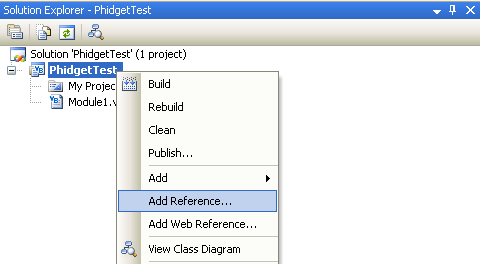
3. Under the .NET tab, select Phidget21.NET.dll.
If you used our installer, these files are installed in C:\Program Files\Phidgets, by default. If it does not appear in this list, then you can browse to the Phidget Framework installation directory and add the file.

The project now has access to the Phidget function calls and you are ready to begin coding.
The same teaching section which describes the examples also has further resources for programming your Phidget.
Visual Studio 2003
Use Our Examples
As the Visual Basic .NET examples were written in Visual Studio 2005 and 2008, Visual Studio 2003 is not able to open the examples. Furthermore, it will be difficult to import the examples into your Visual Studio 2003 project as you will need to recreate the GUI components. Fortunately, taking a look at the source code will give you valuable programming insight. We have a teaching section below to help you follow them.
Write Your Own Code
When you are building a project from scratch, or adding Phidget function calls to an existing project, you'll need to configure your development environment to properly link the Phidget .NET library.
1. Generate a new Visual Basic Console Application project with a descriptive name such as PhidgetTest.
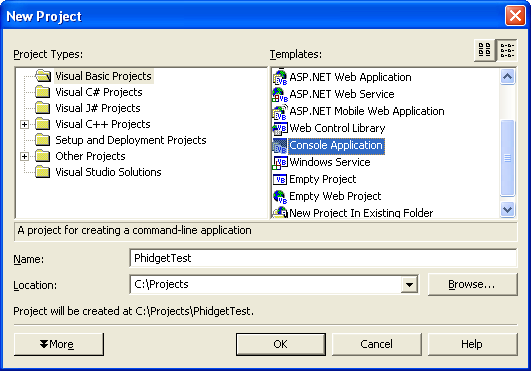
2. Add a reference to the Phidget .NET library.
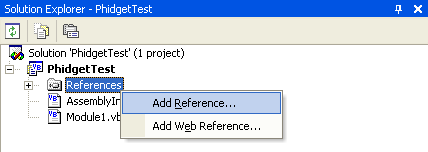
3. Under the .NET tab, select Phidget21.NET1.1.dll.
If you used our installer, these files are installed in C:\Program Files\Phidgets, by default. If it does not appear in this list, then you can browse to the Phidget Framework installation directory and add the file.
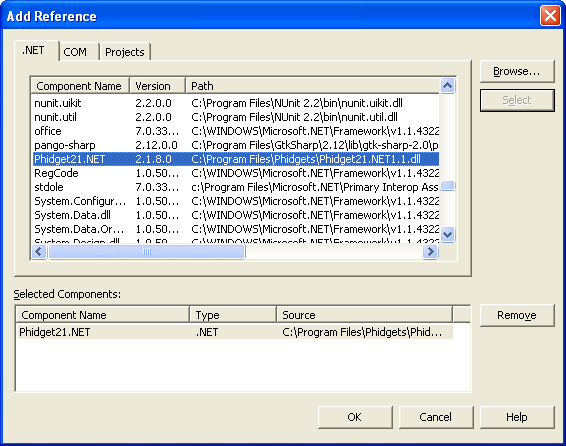
The project now has access to the Phidget21 function calls and you are ready to begin coding.
The teaching section also has further resources for programming your Phidget.
Mono
This section will provide instructions on how to compile using the vbnc compiler.
Use Our Examples
We do not have VB.NET examples for the Mono framework. Fortunately, you can take a look at the source code for our Visual Studio 2005 and 2008 examples for valuable programming insight. We have a teaching section below to help you follow them.
Write Your Own Code
When you are building a project from scratch, or adding Phidget function calls to an existing project, you'll need to configure your compiler to properly link the Phidget .NET library.
Place the Phidget21.NET.dll in the same directory as your source code.
To compile and build an executable, run:
vbnc /out:example.exe /r:Phidget21.NET.dll Example.vb
Afterwards, you will have an executable named example.exe that you can run. Type the following to run the program:
mono example.exe
The teaching section also has further resources for programming your Phidget.
MonoDevelop
Use Our Examples
Download the examples and unpack them into a folder. Here, you can find example programs for all the devices. These examples were written in Visual Studio 2005 and 2008, but are also compatible with MonoDevelop. Please note that the examples are only designed to be ran under the .NET framework. The examples are not compatible with the Mono framework. Despite this, if you are using the Mono framework, you can take a look at the source code for our Visual Studio examples for valuable programming insight. We have a teaching section below to help you follow them.
The rest of this section will explain the steps needed to run our examples under the .NET framework. To load all projects in MonoDevelop, go to File → Open, and open AllExamples/AllExamples.sln
This will load all of the examples available for Visual Basic .NET, and then you can set your main project to be the one that matches your device. If you aren't sure what the software example for your device is called, check the software object listed in the Getting Started guide for your device.
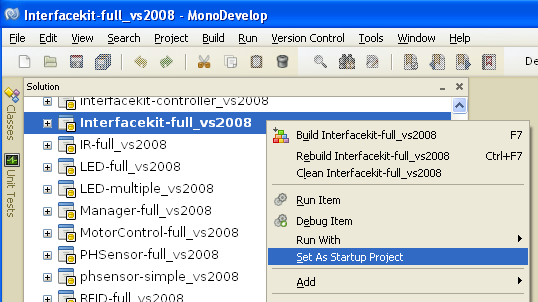
The only thing left to do is to run the examples! Right click the project, and click on Run With and select the Microsoft .NET framework. Please note that the projects, by default try to find the Phidget21.NET.dll in the C\Program Files\Phidgets. If you have it installed in another location, please change the path to the file's location accordingly. If you are receiving an error message regarding that the Phidget is not defined, please re-add the reference to Phidget21.NET.dll. Please see the Write Your Own Code section for details.
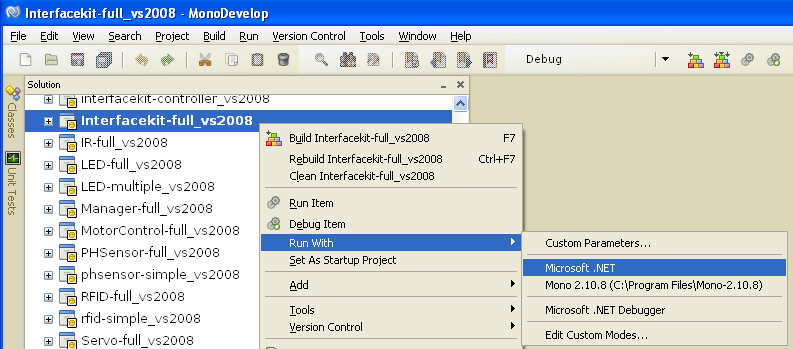
Once you have the Visual Basic .NET examples running, we have a teaching section below to help you follow them.
Write Your Own Code
When you are building a project from scratch, or adding Phidget function calls to an existing project, you'll need to configure your development environment to properly link the Phidget .NET library. To begin:
1. Create a new Visual Basic VB.NET console project with a descriptive name such as PhidgetTest.
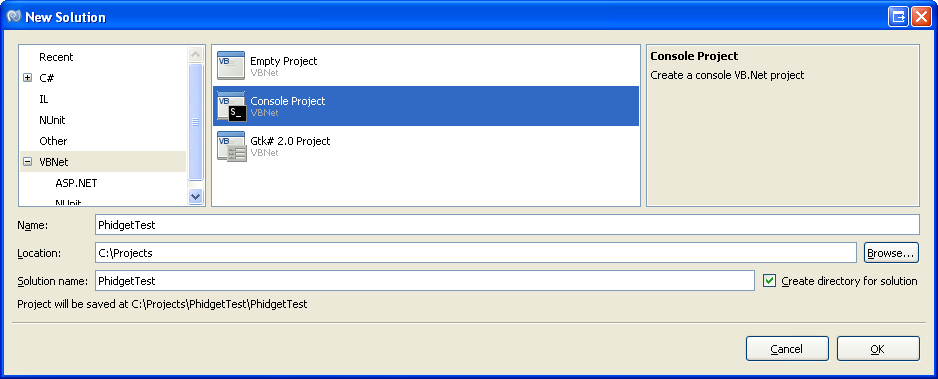
2. Add a reference to the Phidget .NET library.
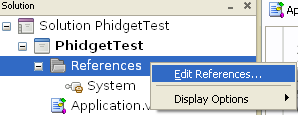
3. Select Phidget21.NET.dll. If you used our installer, by default, this file is placed in C:\Program Files\Phidgets. If it is in another location, please change the path to the file's location accordingly.
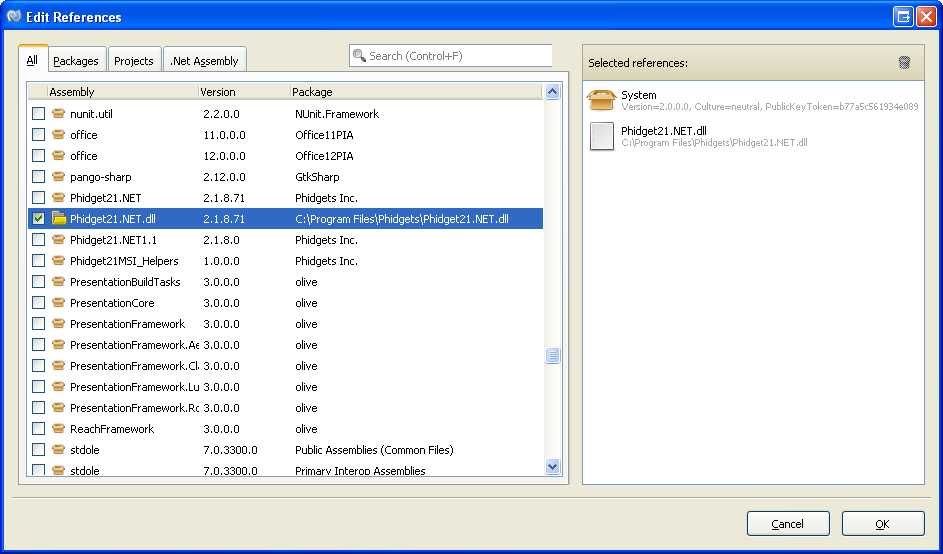
The project now has access to the Phidget function calls and you are ready to begin coding.
The same teaching section which describes the examples also has further resources for programming your Phidget.
Mac OS X
Visual Basic .NET has excellent support on Mac OS X through the Mono framework.
The first step in using Visual Basic .NET on Mac is to install the Phidget libraries. Compile and install them as explained on the getting started guide for your device. Then, the OS - Mac OS X page also describes the different Phidget files, their installed locations, and their roles....
Linux
Visual Basic .NET has support on Linux through the Mono framework.
The first step in using Visual Basic .NET on Linux is to install the Phidget libraries. Compile and install them as explained on the main Linux page. That Linux page also describes the different Phidget files, their installed locations, and their roles.
Follow the Examples
By following the instructions for your operating system and compiler above, you probably now have a working example and want to understand it better so you can change it to do what you want. This teaching section has resources for you to learn from the examples and write your own.
Next, comes our API information. These resources outline the Phidget .NET functions:
Template:UsingAPhidgetInCodeGeneral
Example Flow
Code Snippets
Common Problems and Solutions/Workarounds
Here you can put various frequent problems and our recommended solutions.
